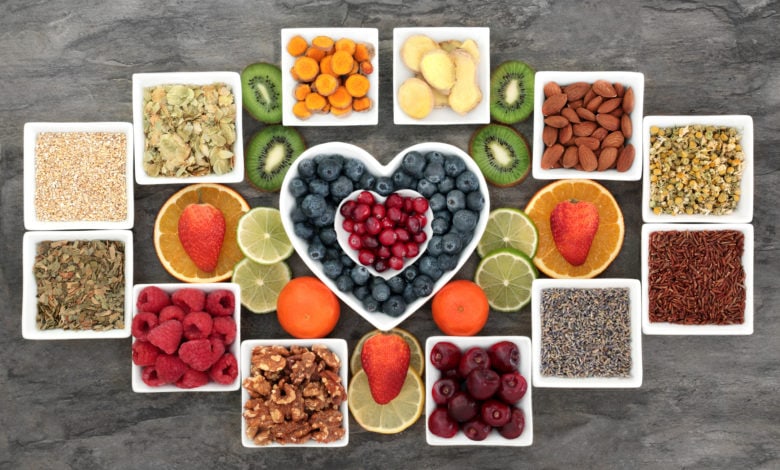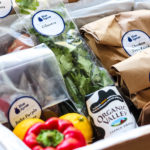Healthy or Harmful? Sneaky Foods That May Make You Gain

Sometimes when we embark on new diet plans we read a lot of information or hear about new health plans from friends or family and all of the foods we “should be eating.”
But a lot of foods we consider to be quite healthy, and have been marketed as healthy choices, may be far from low calorie options.
This may come in the form of a single food, a part of a specific diet plan, or general misconceptions we all have about food. And then when we step on the scale we often feel confused as to why we aren’t losing weight when following a plan or eating healthy, especially if we’re working out on a regular schedule on top of this.
This often lends itself to folks giving up on diet plans and feelings of discouragement and increased confusion. Or turning to popular meal delivery kits where all of the food comes pre-packaged with calorie counts and eliminates all of the hassle involved.
But if you’re eating handfuls of nuts, salads drenched in olive oil, or trying out diets that allow unlimited fruits and vegetables (which aren’t counted towards daily calorie intakes), these healthy foods and plans can effect how you’re calculating your weight loss goal metrics, and ultimately hinder and progress.
While certain foods are quite healthy in moderation, they can also be quite high in calorie per portion. There are other foods that can have simply been marketed as “healthy,” but are actually packed with sugar and/or saturated fats.
The other day I found myself sitting down to a kale and quinoa prepared gourmet salad (my wallet wasn’t happy about this choice). Initially, I thought of it as a worthy investment in a protein-rich healthy light lunch option. But I noticed the salad was densely packed with chunks of feta cheese. While delicious, this was a case of “healthy by association.” The kale didn’t cancel out the cheese.
Sometimes we think of foods as healthy, even if they come with additional ingredients that aren’t as healthy, merely because the main ingredients are good for us. We’ll top frozen yogurt with chocolate and think of it as a better alternative to ice cream, or top a salad with heavy ranch dressing.
Similarly, even if we aren’t on diets, a lot of foods that we consume or the ingredients in them can make us sick (dented canned goods or seafood past expiration dates are perfect examples), and then we’re simply left wondering what we’ve consumed prior.
But what types of foods are the main sneaky culprits effecting your diet? And what plans or regimens may be stifling your weight loss progress goals?
From chain restaurants, to food groups, to plans, we wanted to investigate these misconceptions to find out more. What foods are “sneaky imposters?”
Healthy or Harmful? Foods and Food Groups
Certain foods have been marketed as “healthy” for quite some time, and many of them are quite healthy in moderation. The caveat is that healthy is not always synonymous with low-calorie, and we may end up overdoing it on foods that seem good for us without realizing we’re going over daily carb and calorie counts.
Here are a few “sneaky” healthy foods that may be hurting your weight loss progress:
Granola
Granola (along with some oatmeals) does contain a healthy portion of fat from nuts and seeds, along with rolled oats and dried fruits.
But while this is an excellent source of whole grains and fiber, it is then covered in molasses, sugar, and honey and baked in oil to make it taste better and give it that special “crunch” we all love. Even 1 cup of granola can contain 600 calories, along with 20 grams of sugar. And we typically add fruit and yogurt to turn this into a parfait style option, thinking of this as a healthy pick.
The truth is, a typical breakfast sandwich will probably run you the same amount of calories as a generous granola based parfait option would.
If you do love granola, you can try it in moderation and smaller servings to top healthier low-calorie foods like yogurt or fresh fruit salads.
Smoothies
Smoothies can be extremely healthy, and it’s very dependent on what you put in them that makes or breaks the health and calorie factor here.
Most smoothies you purchase from stores and chains (especially ones containing ingredients like agave or peanut butter), tend to have an extremely high calorie and sugar content, and can easily supplement an entire meal- if not be higher in calorie and carb counts than an actual meal. Some chain smoothie shops sell drinks that exceed 1000 calories total, and yet they still contain fresh fruits and are seemingly harmless.
If you enjoy smoothies, making your own at home using fresh fruits and skim or almond milk can be a much healthier choice that won’t damage any diet plan you’re trying to stick to.
We’ve also tested and reviewed some meal kit options with fresh low-calorie smoothies that are delicious and cost-effective.
Salad Dressings
Salad dressings are the easiest way to make a healthy salad (even if you’ve skipped the cheese and croutons and have opted for the best ingredients) a high-calorie meal option. If you’re drizzling your salad with ranch, thousand island, or french dressing, or adding oil and vinegar to top, this easily adds hundreds of calories to what we usually consider a light lunch option.
If you’re making your own salads at home, read the labels of each dressing carefully, and it’s usually best to opt for simple vinaigrettes. If you prefer creamy dressings as a splurge, there are always non-fat or lower calorie alternatives available, and you can use smaller serving sizes of the same dressing (rather than really pouring it on).
The same can be said for olive oil. While it is dense in healthy fats, it is also quite dense in calories and can really add up if you’re adding it on to a salad (or using it heavily during cooking processes).
You can also make your own dressing at home, or even supplement a dressing with fresh lemon juice or apple cider vinegar.
Sandwich Wraps
Most of us think of wraps, especially if they’re green in color and packed with veggies and/or fresh lean meat, as fairly healthy. Plus wraps are physically thin in size and we tend to think of them as a lighter alternative to rolls, bread, or subs.
The opposite, depending on brand, is usually the case. Typically wraps have more calories, sodium, and saturated fat than two slices of whole grain bread. They also tend to be made with less fiber and more refined flours and hydrogenated oils.
If you do like wraps, make sure to check the ingredients list carefully prior to making one and fill it up with plenty of veggies. You can also make a wrap using lettuce itself (although this is a messier option for most of us).
Prepared Salads (Shrimp, Tuna, Chicken)
Prepared salads you purchase from delis or make on your own may seem healthy and may have plenty of protein (especially in the case of shrimp salad), but the amount of mayonnaise contained in each serving makes calorie and fat contents add up quickly. Shrimp salad can often be one of the worst culprits and contain the highest amount of mayo, simply because of the low density areas in shrimp itself (and the cost of the ingredient).
A single tuna sandwich can easily add up to over 700 calories and 40 grams of fat. It’s best to opt for lean proteins and stick to fresh seafood and meats that you can steam yourself, and add fresh veggies of your choice on the side.
Other foods to be cautious of include those labeled “fat-free” (i.e. reduced or fat free peanut butter often has the same amount of calories as full-fat varieties), dried fruits (which contain much more sugar and calories than fresh fruit), sugary sports drinks and sodas, agave nectar, overdoing it on high-calorie nuts (especially salted peanuts), and even pretzels (which can be low-calorie but very low in nutritional value and leave you feeling hungrier after eating them).
Healthy or Harmful? Restaurants and Plans
A lot of chain restaurants have started adding “light” or “healthy” menu options to their general menus, and some fast food chains have added on healthier options and become more transparent about the nutritional content of their menus. Certain fast food chains, such as Subway, even market themselves as healthy in general.
With diet plans and options, such as Weight Watchers or Jenny Craig, there’s the same concept of health and weight loss in mind.
But what we have to remember is this stems from a place of business profit gains, and it’s important to separate fact from marketing fiction.
In the case of Subway, for example, a footlong veggie delight sandwich is 440 calories. This sounds pretty low considering the size of the sub and the density of the veggies, so we wondered, how can this be accurate when every sandwich is different?
The truth is, the sandwich is technically 10 inches long (aside from the flat bread option), and the calorie count is based on the lowest calorie bread option, and the idea that the customer will not add cheese or any dressing. However, most customers add cheese, dressing, or both to the sandwich. So if you add a generous portion of mayo or another creamy sauce along with cheese to your sandwich, you may be looking at an additional 500 calories or so, without even realizing it.
With chain restaurants with healthy menu options, many of them fail to add dressings and side options to the total calorie count as well. So it is often best to request these additions on the side of your order.
Diet plans can also be a bit wonky. A good example of this is the Weight Watchers points system plan. While many have had excellent results and seen success using WW, there is a small percentage of dieters left confused by their mixed results. The . plan tracks all fruits and vegetables as “0 points” towards your daily intake.
The problem with this is if you were to eat several avocados or sugary servings of fruit per day on top of a healthy diet without taking this into consideration, it would definitely throw off your metrics (in terms of calories expended and daily intake).
So certain chain restaurants, nutritional information provided, and even diet plans themselves can also be slightly “sneaky,” and leave us feeling confused if we feel we’ve made good choices.
The key is in being mindful in calculations, ordering portions on the side, and considering how chain restaurant nutrition information and diet plan recommendations are not always “set in stone.”
We need to exercise our own logic and make active choices along with these suggestions.
Healthy or Harmful? The Takeaway
Ultimately, between all we’ve been told via the media and marketing and all that simply “seems healthy,” it can be quite confusing to make the right choices without breaking the calorie bank.
By following simple rules and enjoying foods in moderation, preparing foods that you may be uncertain about at home, and by realizing that foods are not simply healthy by association (i.e. toppings on salad or yogurt), you can stick to your diet plan and eliminate a lot of frustration.
It’s important to be aware of foods, diets, and even restaurants that have been marketed as “healthy” and are promoted as such, and always actively question the nutritional content of what you’re actually consuming.
Most restaurants have online nutritional information which can be very helpful, and you can do your own online research to get calorie counts on any food you want.
Self-preparation is often key, and if you’re really confused you may also want to opt for a meal service kit with pre-portioned foods and calorie counts to eliminate any confusion or hassle to begin with.
Awareness is key, and once we know that some “healthy” foods are simply marketing imposters, we can start to make healthier choices and see the results of our efforts when we step on the scale.
Beverly joined MFS with a diverse breadth of experience in writing and digital marketing. Throughout the years of placing recipes on MFS, I’ve noticed an uptick in the number of “subscription boxes” for the cooking/food market. It was then that I decided to also include my own personal review of these subscriptions on MFS.





